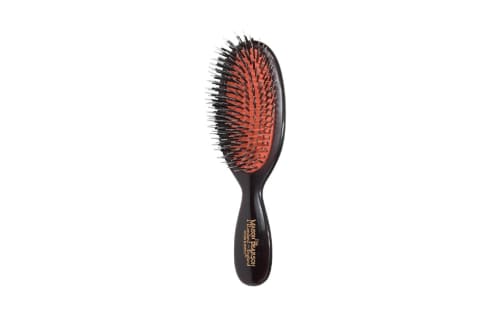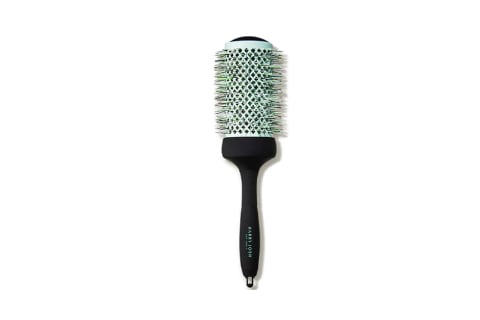Advertisement
How To Clean Hair Brushes In 4 Steps & How Often To Do It


Are you a hairbrush aficionado, or have you used the same bright pink paddle brush since high school? There tends to be two types of people, but still one thing remains the same: Most of us aren’t cleaning our hair brushes enough, if ever.
While this may be one more chore to add to the list, it’s pretty important. To come, why you should add this step to your to-do list and how experts recommend doing it.
Why does my brush get dirty?
Unfortunately, it's not just stray hairs that clog up brushes, but dead skin cells, hair gels, leave-in conditioner, oil from your scalp, fungus, bacteria, dandruff, and more, certified trichologist and founder of alodia Isfahan Chambers-Harris, Ph.D. tells mbg.
When you brush your hair, this plethora of buildup can pass from scalp to brush and back again until you cleanse it.
You probably haven’t really looked at your hairbrush before, which is fair. But if you shine a flashlight on your tool, you can spot the white and yellow colored particles clogging up your brush. It doesn’t sound pretty, but sometimes it’s the only way to motivate yourself to clean your brush.
Before you ask—yes, this step is essential for your scalp health. “When you don't wash your brush, it can cause an imbalance to the scalp microbiome which can cause scalp conditions such as dandruff and scalp infections that can lead to hair loss,” Chambers-Harris notes.
“You can also spread oils, which can contribute to making your hair dirty,” adds board-certified dermatologist Hadley King, M.D., FAAD In other words, your greasy roots could be exacerbated by a dirty hair brush.
A dirty brush could be combination of:
- Sebum from your scalp
- Hair product
- Dirt
- Dead skin cells
- Dandruff
- Bacteria
- Fungus
A general how-to guide on cleaning your hair brush
Not sure how to wash your brush? Here’s a step-by-step guide to keep on hand.
What you’ll need:
- Antibacterial soap or shampoo
- A clean towel
- Warm water
- Optional: A brush cleaning tool (like this one from Amazon)
Cleaning method
Step 1: Pull out hair
First things first, you need to get the hairs out, all of them. You may be able to pull out all the hairs yourself, but you may need help with a thinner tool to help snake out the strands.
"They make tools to remove hair from brushes that have been around for years. I'd recommend a wire one, they work the best, like this one from Amazon," says Bowman.
Don't want to make a special purchase? You can use any of the following:
- The long tail of a comb
- Picks
- A thin pen
- Scissors
- Any long and sturdy object that you can weave through the bristles
Step 2: Apply soap & scrub
Step 3: Rinse
After you’ve scrubbed your brush for a few minutes, it’s time to rinse it out. Be sure to rinse with warm water, and go back in for a second scrub if you notice buildup and oil still present. Rinse the brush thoroughly to ensure all of the soap or shampoo is gone
Step 4: Dry
Finally, let your brush dry completely before using it. First pat it with a towel to soak up excess water droplets, then let your brush air dry.
“Place your flat brushes upside down to allow the water to drain to prevent mold growth,” Pettway notes. This may take a few hours, so it’s best to wash your brush before bed so it’s ready for action by morning should you need it.
How to adjust based on brush types
Depending on what brush type you have, the process may vary slightly.
- Boar bristle: For boar bristle brushes, it’s best to skip the soak, be gentle when you scrub, and use a super gentle, sulfate-free shampoo like the Davines SOLU Shampoo. Always rinse these brushes with cold water rather than warm.
- Round: Round brushes (those you typically use for blowouts) can be more difficult to cleanse given the shape. If you have a bristle round brush (read: not metal or plastic), opt for a gentle soap and cool water as well.
- Plastic or metal: Any brush made of plastic or metal will be more durable. Plastic is generally fine to soak, but you may want to skip the soak with metal brushes.
- Wooden: If the base or handle of your brush is made from wood, you definitely should not be soaking it. In addition, try to cleanse the bristles without scrubbing the wood too much, to reduce the risk of damage or seal chipping.
How often do you need to clean your hair brush?
Now let’s get down to details. “If you use your brushes every day, then you should wash them at least once a week,” says Davines Regional Master Trainer and Stylist, Theo Pettway. If you use your brush on occasion, you may only need to wash it monthly.
The exact cadence will also depend on what concerns you have and what state your hair is in. If you’re prone to dandruff, oily roots, and product buildup, then you should definitely stick with weekly washes at least.
That being said, a quick daily hair removal can’t hurt. "Hair should be removed from the brush after every use, for easy removal," says Michael Bowman, hairstylist at Rob Peetoom in Brooklyn.
This is pretty simple, and honestly not that big of an ask. Just pull out errant strands after you've run the brush through your hair. This will help keep the tool cleaner, too, so when you do deep clean it, it's not as much of a task.
Our experts note that you can use soap or shampoo, depending on your preference and brush type. If you opt for shampoo, stick with a sulfate-free option to protect the bristles.
If your brush is made of metal or plastic, you can soak it in soapy water for 15 minutes, Chambers-Harris says, but skip this step if it’s made of any other material.
After your brush is damp and covered in soap, it’s time to scrub. You can use an old toothbrush or get a formal brush cleaning tool as mentioned above.
A lot of that buildup is actually oil- and silicone-based products, which repel water, so you'll really need to get in there with the soap and your hands or tools. Of course, be gentle enough not to break any bristles themselves.
Summary
What type of soap should you use?
What cleanser you use will depend on your brush and personal preference. Below, a few different options to consider:
- Antibacterial soaps: If you're looking for a good antibacterial soap of the natural variety try Beauty By Earth Body Wash or Dr. Bronner's Pure Castile Soap.
- Shampoos: You can also use shampoos to clean them, like any of these sulfate-free options that use gentle surfactants to help clean. Or, if you have one, use a clarifying shampoo, as they are formulated to cut through oil more effectively.
- DIY soaps: Love a DIY route? So do we. Here's a DIY clarifying shampoo that utilizes baking soda you can use to clean your brush as well. Be sure to skip this one on boar bristle brushes, though.
How often should you replace brushes?
“If the bristles in your brush are warped from prolonged use, or you have missing bristles, then it’s definitely time to change your brush,” says Pettway. If you don’t change your brush, you run the risk of snagging your strands and scratching your scalp.
“Besides that, most brushes are made to last a long time, so you won’t have to throw away a good brush,” he adds. If you regularly wash your brush, it will last even longer, too.
FAQ
Are you supposed to wash hair brushes?
Yes, you should wash your hairbrush. Unfortunately, it's not just stray hairs that clog up brushes, but dead skin cells, hair gels, leave-in conditioner, oil from your scalp, fungus, bacteria, dandruff, and more, certified trichologist and founder of alodia Isfahan Chambers-Harris, Ph.D. tells mbg.
When you brush your hair, this plethora of buildup can pass from scalp to brush and back again until you cleanse it.
How often should you wash your hair brush?
“If you use your brushes every day, then you should wash them at least once a week,” says Davines Regional Master Trainer and Stylist, Theo Pettway. If you use your brush on occasion, you may only need to wash it monthly.
The exact cadence will also depend on what concerns you have and what state your hair is in. If you’re prone to dandruff, oily roots, and product buildup, then you should definitely stick with weekly washes at least.
That being said, a quick daily hair removal can’t hurt. "Hair should be removed from the brush after every use, for easy removal," says Michael Bowman, hairstylist at Rob Peetoom in Brooklyn.
Can I clean my brushes with shampoo?
You can use shampoos to clean them, like any of these sulfate-free options that use gentle surfactants to help clean. Or, if you have one, use a clarifying shampoo, as they are formulated to cut through oil more effectively.
The takeaway
For those using a hairbrush daily, try to deep clean your brush once a week. Use antibacterial soap or sulfate-free shampoo to complete this step, and always dry your brushes upside down.
This will help to prevent the spread of bacteria, oil, and building from brush to strand and vice versa. When you’re doing this, you may as well clean your makeup brushes while you’re at it—here’s how.



